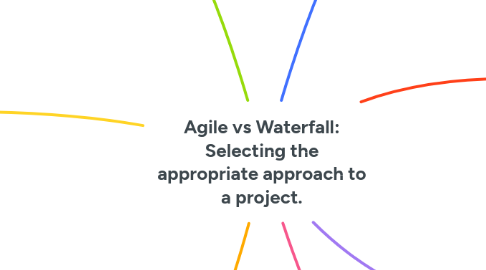
1. Justification and Types
1.1. What it is a procedural model
1.1.1. Organizer of methods and tools of project management into project phases or processes in a standardized manner.
1.1.2. Influenced by how projects are managed and changing market conditions like: - New technologies. - Short time-to-market cycles. - Factors of social and business world. - Different types of projects.
1.2. Types
1.2.1. 1. Classical Waterfall Process. 2. Agile methods 3. Hybrid approaches
2. Agile methods
2.1. Characteristics
2.1.1. - Solutions step by step. - Less commitment. - Results with the customer in very short cycles. - Steps required to achieve the objectives may be unclear. - Defines goals in a low level detail. - Shorter planning horizon (two to four weeks). - For project process with not linear successive phases. - Multiple iterations. - React quickly to changing customer requirements.
3. Hybrid approaches
3.1. Characteristics
3.1.1. - Got the “big picture” planned by waterfall process, following a structure of a higher-level giving a classical project plan - Subprojects are managed in an agile, this subprojects take advantage of agile characteristics such as transparency and adaptability - High communication - Short feedback cycles subprojects
4. Classical Waterfall Process
4.1. Characteristics
4.1.1. - Planning and execution. - Expected results. - Communication by the client at the beginning of the project. - Worked through in a goal- and plan-oriented manner. - Planned holistically from kick-off to completion with deadlines. - Work packages. - Responsibilities.
4.2. Benefits
4.2.1. - Stability. - Structure. - Predictable resources. - Documented planning.
5. Main difference between them
5.1. Six main domains, in order of difference they are: 1. Planning character. 2. Core of the project work. 3. Work Culture. 4. Leadership of the project team. 5. Evolution towards project goal. 6. Documentation.
5.1.1. Classical Waterfall
5.1.1.1. The initial plan is the of the project work.
5.1.1.2. Clear roles and responsibilities, and stable, systematic, and documented planning.
5.1.1.3. Ppredict the capacities of the team members and the measurability of the project progress.
5.1.2. Agile Projects
5.1.2.1. Process of transparent communication, frequent feedback from the customer and a high level of flexibility.
5.1.2.2. Recognize change requirements in a very short time.
5.1.2.3. React flexibly and quickly to dynamically changing customer requirements.
6. Disadvantages of each one
6.1. Classical Waterfall
6.1.1. Initial requirements can be abstract so this makes mistaken assumptions in the planning process.
6.1.2. Customers are overburdened by specify all the requirements clearly and in detail.
6.2. Agile Projects
6.2.1. Iterative approach doesnt work with: - Planning. - Reporting. - Hierarchical structures. - Leadership.
6.2.2. Project success depends of the team’s skills and its members’ ability to organize.
7. Select the appropriate approach
7.1. By exclusion criteria
7.1.1. We can have “knockout criteria” structured according to the nature of the project and the nature of the organization or project sponsor, and follows established findings
7.2. Catalog of criteria
7.2.1. In order of importance: (4) characteristic is fully applicable (3) characteristic applies to a large extent (2) characteristic is partially applicable (1) characteristic applies only to a very limited extent (0) characteristic does not apply.
